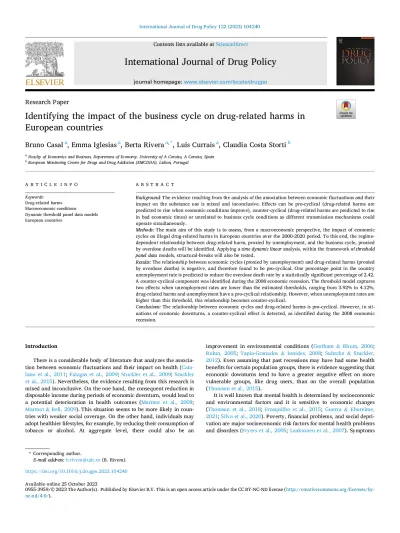Summary
The evidence resulting from the analysis of the association between economic fluctuations and their impact on the substance use is mixed and inconclusive. Effects can be pro-cyclical (drug-related harms are predicted to rise when economic conditions improve), counter-cyclical (drug-related harms are predicted to rise in bad economic times) or unrelated to business cycle conditions as different transmission mechanisms could operate simultaneously.Download as PDF
PDF files are made available as a convenience. In cases where the EMCDDA is not the originator of the document, please be aware that any PDFs available on this page may not be authoritative or there may be more recent versions available. While we make every effort to ensure that these files are definitive, before using or citing them, we recommend that you consult the publisher's website or contact the author(s) to check for more recent versions.
Abstract
Background
The evidence resulting from the analysis of the association between economic fluctuations and their impact on the substance use is mixed and inconclusive. Effects can be pro-cyclical (drug-related harms are predicted to rise when economic conditions improve), counter-cyclical (drug-related harms are predicted to rise in bad economic times) or unrelated to business cycle conditions as different transmission mechanisms could operate simultaneously.
Methods
The main aim of this study is to assess, from a macroeconomic perspective, the impact of economic cycles on illegal drug-related harms in European countries over the 2000-2020 period. To this end, the regime-dependent relationship between drug-related harm, proxied by unemployment, and the business cycle, proxied by overdose deaths will be identified. Applying a time dynamic linear analysis, within the framework of threshold panel data models, structural-breaks will also be tested.
Results
The relationship between economic cycles (proxied by unemployment) and drug-related harms (proxied by overdose deaths) is negative, and therefore found to be pro-cyclical. One percentage point in the country unemployment rate is predicted to reduce the overdose death rate by a statistically significant percentage of 2.42. A counter-cyclical component was identified during the 2008 economic recession. The threshold model captures two effects: when unemployment rates are lower than the estimated thresholds, ranging from 3.92% to 4.12%, drug-related harms and unemployment have a pro-cyclical relationship. However, when unemployment rates are higher than this threshold, this relationship becomes counter-cyclical.
Conclusions
The relationship between economic cycles and drug-related harms is pro-cyclical. However, in situations of economic downturns, a counter-cyclical effect is detected, as identified during the 2008 economic recession.









